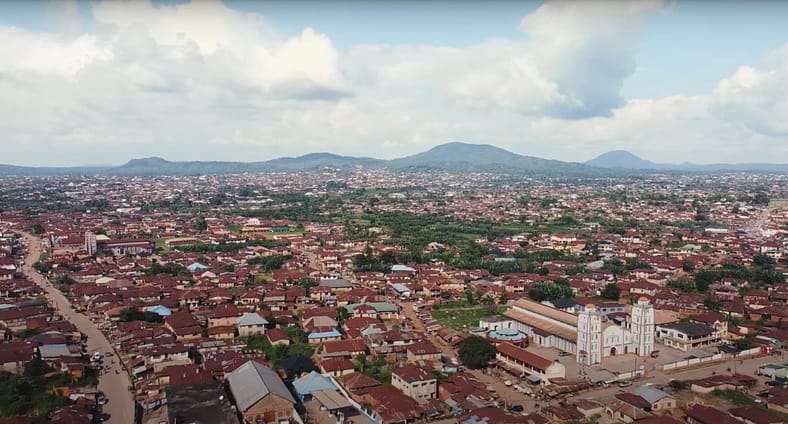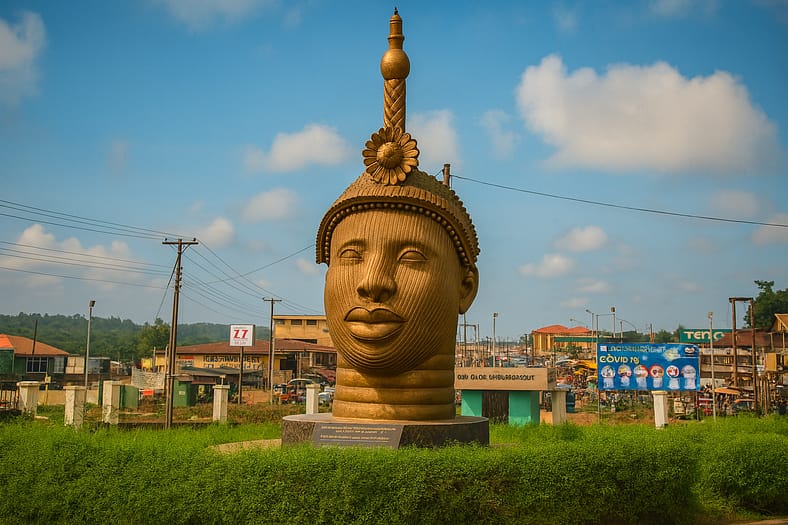The Call of Sacred Cities

Across the world, people undertake pilgrimages to sacred places, drawn by faith, history, and the yearning to touch the divine. Muslims journey to Mecca, Christians to Jerusalem, and Hindus to Varanasi. These cities are not just destinations; they are living symbols of collective memory and spiritual belonging.
In that same spirit, the Yoruba people, one of Africa’s most culturally rich and historically influential civilizations, have their own Sacred City: Ilé-Ifẹ̀.
Nestled in the rolling landscapes of Osun State, Nigeria, Ilé-Ifẹ̀ is more than an ancient town; it is a living testament to creation, kingship, and artistic brilliance. It is the point where, according to Yoruba cosmology, the world itself began, a city where heaven and earth once touched.
Yet, despite its immense significance, the full story of Ilé-Ifẹ̀ remains under-told. At Afrikanspective, we believe that telling our own stories is an act of preservation and empowerment. Ilé-Ifẹ̀’s narrative, stretching across spirituality, art, education, and modern identity, deserves to be celebrated, documented, and passed on as a cornerstone of Yoruba Civilization.
The Mythic Beginning: Where Heaven Touched Earth
Odùduwà and the Birth of Civilization

According to Yoruba oral tradition, the story of Ilé-Ifẹ̀ begins in the divine realm. It was here that Odùduwà, the ancestral progenitor of the Yoruba people, descended from the heavens carrying the sacred materials of creation.
The gods had chosen a spot where the world would begin, a fertile land where life would take root. Odùduwà poured sand upon the waters, released a cockerel to spread it, and from that sacred act, the earth, Ilé-Ifẹ̀, emerged.
From that moment, the Sacred City became the spiritual and political nucleus of Yoruba Civilization. Every Yoruba king traces his lineage back to this act of divine creation, making the city not just a birthplace of civilization but a cosmic homeland.
The Divine Blueprint: How Ilé-Ifẹ̀ Became the World’s Center
For the Yoruba, Ilé-Ifẹ̀ is the navel of existence, the axis where humanity and divinity meet. Its name itself translates to “The House of Expansion”, a place where life, culture, and consciousness unfold.
From the deities (òrìṣà) to the royal lineages, everything flows outward from Ilé-Ifẹ̀. To visit it is to reconnect with one’s spiritual DNA and the sacred origin of Yoruba Civilization.

The Golden Age of Ifẹ̀ Art and Innovation
Between the 11th and 15th centuries, Ilé-Ifẹ̀ flourished as a vibrant city-state, producing some of the most refined artworks in African history. The world-renowned Ifẹ̀ bronzes and terracotta heads, discovered by archaeologists in the 20th century, stunned historians with their realism, craftsmanship, and aesthetic sophistication.
These artifacts revealed a city that was technologically advanced, mastering metallurgy, glass bead production, and urban planning long before Europe’s Renaissance. Each bronze head told the story of divine kingship, the blending of human authority and spiritual power.
Ifẹ̀’s art was not mere decoration; it was theology cast in metal, history molded in clay. These masterpieces remain a defining heritage of the Sacred City and an enduring emblem of Yoruba Civilization.
A Hub of Trade and Knowledge
Strategically positioned, Ilé-Ifẹ̀ connected ancient trade routes across West Africa. Merchants brought ivory, gold, glass beads, and ideas, while local artisans transformed them into masterpieces.
By the 14th century, the influence of the Sacred City reached across Benin, Oyo, and beyond, shaping political models and artistic traditions that still define Yoruba Civilization today.
The Living City: Ilé-Ifẹ̀ in Modern Times

Obafemi Awolowo University and Academic Renaissance
Today’s Ilé-Ifẹ̀ is not frozen in the past. It pulses with life, modern, spiritual, and intellectual. At its heart stands Obafemi Awolowo University (OAU), one of Africa’s most prestigious institutions.
OAU represents the rebirth of Yoruba intellectualism, carrying forward the ancient Ifẹ̀ spirit of scholarship, debate, and creativity. The campus itself, adorned with sculptures and cultural symbols, mirrors the harmony of art and thought that defines Yoruba Civilization.
Cultural Continuity and Modern Festivals

Throughout the year, the Sacred City hosts vibrant festivals celebrating Odùduwà, Moremi, and the Ọọ̀ni’s lineage. These events unite the community, blending drumming, dance, masquerade, and prayer into a living symphony of faith.
Here, tradition is not relic; it is rhythm, sound, and soul.
Seven Sacred and Cultural Landmarks of Ilé-Ifẹ̀
1. The Ọọ̀ni’s Palace – A Living Throne of Tradition

The Aafin Ọọ̀ni stands as the beating heart of Ilé-Ifẹ̀. It is not just a royal residence but a spiritual court where ancient rituals and modern governance meet. Within its sacred walls, the Ọọ̀ni preserves the link between the ancestors and today’s Yoruba Civilization.
2. National Museum of Ilé-Ifẹ̀ – Guardians of Ancient Art

This museum houses priceless bronzes, terracotta sculptures, and relics that tell the story of the Sacred City. Each artifact reveals the artistic genius of the Yoruba and stands as evidence that Africa’s civilization was advanced long before colonial history began.
3. Odùduwà Shrine and Sacred Grove

Hidden among trees and earth-scented paths, the Odùduwà Shrine marks the divine descent of creation. Pilgrims visit to honor the founder of the Yoruba people, reconnecting with a faith that is both spiritual and ancestral.
4. Opa Oranmiyan – The Pillar of Power

The towering Opa Oranmiyan is a monumental stone symbolizing strength and leadership. Said to be erected by Oranmiyan, son of Odùduwà, it represents royal courage and the unbroken heritage of Yoruba Civilization.
5. Statue of Queen Moremi Ajasoro – Heroine of Courage

Standing over 40 feet tall, the statue of Moremi celebrates a queen who sacrificed herself to save her people. Her legend embodies bravery, loyalty, and the vital role of women in the Sacred City’s story.
6. Obafemi Awolowo University Campus – A Modern Legacy

OAU is more than an institution of learning; it is a living continuation of Ifẹ̀’s legacy. Its architecture and atmosphere reflect a seamless blend of tradition, intellect, and innovation that keeps the Yoruba spirit alive.
7. Natural Attractions Around Ifẹ̀ – Beauty and Belief

The Opa River, Erin-Ijesha Waterfalls, and nearby hills remind visitors that nature is also sacred. These sites combine peace, beauty, and spirituality, offering travelers a deeper connection to the Sacred City.
Why Ilé-Ifẹ̀ Matters More Than Ever
The Importance of Telling Our Own Story
For too long, Africa’s narratives have been filtered through external lenses. It is time to reclaim the narrative, to celebrate Ilé-Ifẹ̀ as the cradle of Yoruba Civilization and the Sacred City of a people whose culture has shaped nations.
Heritage Tourism as Economic Empowerment
Ilé-Ifẹ̀ holds immense potential as a global heritage tourism hub. Developing cultural routes, training local guides, and promoting authentic Yoruba crafts can transform the Sacred City into a center of sustainable economic and cultural growth.
Visiting Ilé-Ifẹ̀: A Modern Pilgrimage
Travelers today come not only to worship but to learn, research, and reconnect deeply with heritage. Whether walking through the Ọọ̀ni’s Palace, admiring the Ifẹ̀ bronzes, or attending a traditional festival, every step in the Sacred City is a step into the living heart of Yoruba Civilization.
FAQs about Ilé-Ifẹ̀ and Yoruba Civilization
- Why is Ilé-Ifẹ̀ called the cradle of Yoruba civilization?
Because Yoruba cosmology teaches that creation began there, and historical evidence shows it as the earliest center of Yoruba art, governance, and spirituality. - What is the significance of Odùduwà in Ilé-Ifẹ̀?
Odùduwà is regarded as the divine ancestor and first ruler who founded Ilé-Ifẹ̀, linking heaven and earth in Yoruba belief. - Are the Ifẹ̀ bronzes really that ancient?
Yes. Dating from around the 11th to 15th centuries CE, they demonstrate sophisticated metalwork long before European contact. - Can non-Yoruba visitors go to Ilé-Ifẹ̀?
Absolutely. The Sacred City welcomes all visitors interested in history, culture, and spirituality, provided respect for local customs is observed. - What is the Opa Oranmiyan?
It is a tall stone monolith symbolizing the legendary prince Oranmiyan, a marker of royal heritage and Yoruba unity. - How can Ilé-Ifẹ̀ contribute to Nigeria’s tourism industry?
Through investment in heritage preservation, guided tours, digital storytelling, and partnerships with cultural organizations.
Conclusion – Remembering the Source
Ilé-Ifẹ̀ is not merely an ancient city; it is the heartbeat of Yoruba consciousness. Just as Mecca and Jerusalem anchor faith and identity for millions, Ilé-Ifẹ̀ anchors the Yoruba Civilization as a Sacred City of memory and pride.
To walk its soil is to touch history. To tell its story is to keep our roots alive.
At Afrikanspective, we say: Let us remember Ilé-Ifẹ̀ not as legend, but as living heritage, our origin, our pride, our sacred heart.



1 Comment
bravo!!